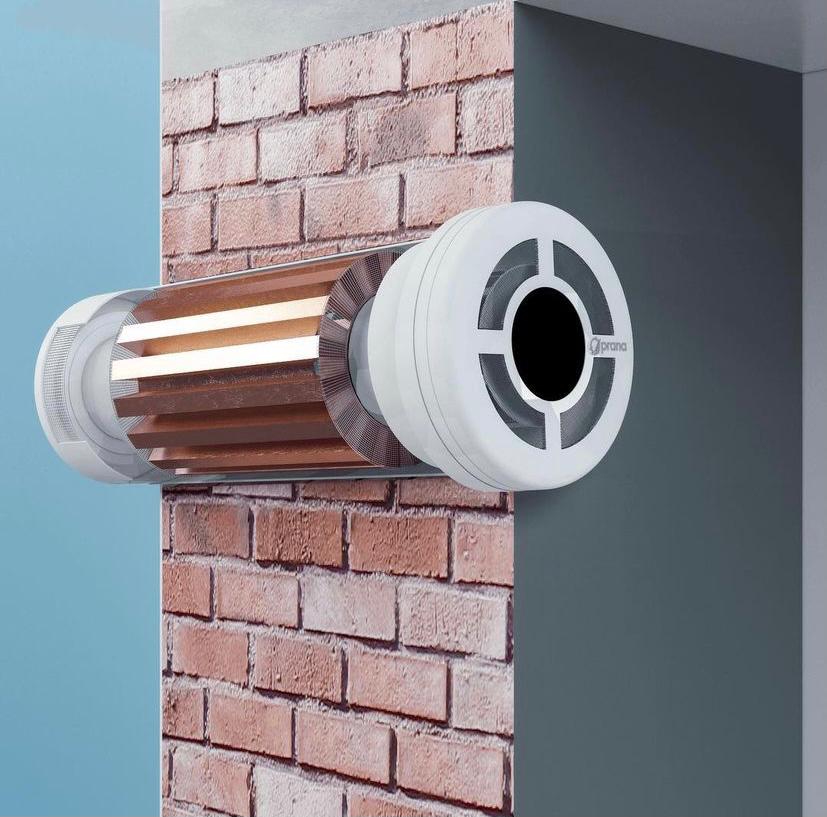
What is Energy-efficient Ventilation System?
Energy-efficient ventilation, or a heat recovery ventilation system (HVAC) is an innovative technology that not only helps to reduce energy consumption, but also promotes a healthier and more comfortable indoor environment.
A heat recovery ventilation operates on a simple yet ingenious principle: it utilises the temperature difference between outgoing stale air and incoming fresh air.
Proper ventilation with heat recovery unit is crucial for maintaining a healthy indoor environment. Heat recovery units ensure a continuous supply of fresh air is provided to your property, while also filtering out impurities and pollutants.
This helps to improve indoor air quality, reducing the risk of respiratory issues and creating a more comfortable living or working space.
Modern heat recovery ventilation with a cooper heat exchanger are designed with noise reduction in mind. The units are equipped with insulated enclosures and advanced fan technologies, ensuring that they operate quietly. This makes them suitable for various settings, including bedrooms, habitable rooms, bathrooms and whole house, where noise levels need to be minimised!
The Prana Recuperator/ decentralised MVHR is an energy efficient, a quick-to-assemble, smartphone-controlled ( Bluetooth, wi-fi) ventilation system that can solve all of your problems! It utilises an innovative system of CO2, humidity, air quality VOC, temperatures sensors to monitor, correct and control the air quality, CO2, humidity and temperature in any indoor environment with different filters. It’s similar to autopilot. With a two-year warranty and ten-years lifespan, the Prana Recuperator/ dMVHR has your future covered.
Our advantages
Improve Your House with a Heat Recovery Ventilation Systems
Heat recovery unit offers a multitude of benefits for homeowners, ranging from improved energy efficiency and enhanced indoor air quality to consistent temperature control, noise reduction, financial savings, and positive environmental impact – overall, these amount to a better quality of life!
Heat recovery systems are designed to recover and reuse the heat that is typically lost during ventilation or air extraction processes. By capturing and redistributing this wasted heat, these systems significantly improve energy efficiency in your home. This means that you can reduce your reliance on traditional heating and cooling methods, resulting in substantial energy savings and lower utility bills.
By installing a heat recovery system in your home, you can optimise your living space while contributing to a more sustainable future! Contact us right now
FAQ
Heat recovery is an option used in domestic dwellings, which helps to reduce the heating and cooling demands of buildings.
Heat recovery systems are a technology that capture and reuse excess heat in the air, or heat generated by various industrial processes or HVAC (heating, ventilation, and air conditioning) systems. They help to reduce energy consumption and improve overall efficiency by recovering and transferring this heat to other areas or processes.
If the term “MVHR”, or Mechanical Ventilation with Heat Recovery, “dMVHR”, or decentralised Mechanical Ventilation with Heat Recovery sounds complicated, don’t worry! It’s actually a straightforward process that can be broken down into three simple steps:
- Stale air is extracted from the room while fresh air is drawn into it by the ventilation unit. This creates a continuous airflow.
- The heat recovery ventilation unit (HRV system), MVHR, decentralised MVHR recovers the heat from the extracted stale air and transfers it to the incoming fresh air.
- The clean, temperature-regulated air is distributed throughout the property.
Using an environmentally-friendly heat recovery ventilation system offers several advantages, including reduced energy costs. By reusing exhaust heat, your overall energy consumption can be significantly reduced. Heat recovery systems also help to lower greenhouse gas emissions and decrease the carbon footprint of industries and buildings.
Heat recovery systems can be used in a broad variety of sectors, including industrial or commercial buildings and residential settings; they can be implemented in manufacturing plants, hospitals, data centers, hotels, swimming pools, and more. Essentially, any process that generates surplus heat can potentially benefit from a heat recovery system.
Yes, heat recovery systems can often be retrofitted into existing buildings, even if they already have their own ventilation system fitted, provided there is sufficient space and compatibility. However, the feasibility and cost-effectiveness of retrofitting may vary depending on the specific situation and the complexity of integration.
We always recommend you consult with a qualified professional or an energy engineer to assess the suitability and design of a heat recovery system for your specific needs.
Regular maintenance is an important way to safeguard the optimal performance and longevity of a heat recovery system. This typically includes cleaning or replacing filters, inspecting heat exchangers for any grime or corrosion, checking fans and motors, and making sure that nothing is obstructing airflow.
We recommended that you follow the manufacturer’s guidelines and consult with a qualified technician or service provider for routine maintenance.
Contact us
SEND YOUR MESSAGE























